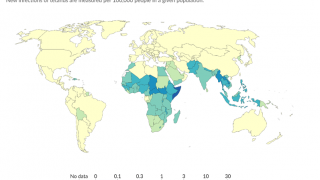Diphtheria Cases Can Be Reduced in Europe By Increasing Vaccinations

An unusual surge in the number of toxigenic diphtheria infections was noted in several European countries in the summer of 2022.
According to research published by the New England Journal of Medicine on June 4, 2025, a total of 20 cases of diphtheria were reported across six European countries from January to July 31, 2022.
After July, there was a steep increase in case numbers, with 38 cases reported in August, 74 in September, and 115 in October, before the number plateaued at 116 cases across 10 countries in November 2022.
Led by Germany with 118 patients, Austria (66), the United Kingdom (59), Switzerland (52), and France (30 patients), the median age of the patients was 18 years at the time of data collection.
This outbreak represents the most significant rise in diphtheria cases seen in Western Europe in the past 70 years.
From an origin perspective, 222 patients (83.5%) were reported to have originated from Afghanistan or Syria, and most followed a migration route through the western Balkans.
This Original Article disclosed that four major genetic clusters were identified, which indicated the multiclonal nature of the diphtheria outbreak.
Genetic clusters from the original outbreak were also identified in 2023, which suggests sustained foci of infection.
Secondary cases in vulnerable populations, such as persons experiencing homelessness and intravenous drug users, were also identified. The secondary instances underscore the need for enhanced public health measures and heightened clinical awareness.
These researchers concluded, 'The large number of C. diphtheriae infections among migrants is a cause for concern, particularly given that antimicrobial-resistance phenotypes threaten the efficacy of first-line treatments.'
According to the ECDC, at the end of April 2025, Germany reported a diphtheria outbreak linked to the 2022 outbreak and was also detected in a few cases in 2023.
Diphtheria is a vaccine-preventable, potentially life-threatening disease that typically causes respiratory illness but can also cause cutaneous lesions. The causative agents of diphtheria are toxigenic strains of the bacterium Corynebacterium diphtheriae.
As of June 19, 2025, most countries in Europe and worldwide have access to effective diphtheria vaccines, such as DTaP, Tdap, and Td.
In the United States, the Centers for Disease Control and Prevention (CDC) reports that diphtheria is now a rare disease, mainly due to a high vaccination rate. Universal childhood vaccination began in the 1940s, with vaccines offered at most clinics and pharmacies.
The CDC recommends that you ensure you are up to date on all routine vaccines, including Diphtheria-Tetanus-Pertussis, when traveling internationally.
Our Trust Standards: Medical Advisory Committee




